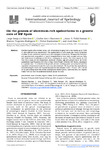Mostrar o rexistro simple do ítem
On the Genesis of Aluminum-Rich Speleothems in a Granite Cave of NW Spain
| dc.contributor.author | Sanjurjo-Sánchez, Jorge | |
| dc.contributor.author | Arce-Chamorro, Carlos | |
| dc.contributor.author | Vidal Romaní, Juan Ramón | |
| dc.contributor.author | Vaqueiro-Rodríguez, Marcos | |
| dc.contributor.author | Barrientos, Víctor | |
| dc.contributor.author | Kaal, Joeri | |
| dc.date.accessioned | 2021-04-21T15:26:28Z | |
| dc.date.available | 2021-04-21T15:26:28Z | |
| dc.date.issued | 2021-02-22 | |
| dc.identifier.citation | Sanjurjo-Sanchez, Jorge; Carlos Arce Chamorro; Juan Ramón Vidal Romaní; Marcos Vaqueiro-Rodríguez; Victor Barrientos; and Joeri Kaal. 2021. On the genesis of aluminum-rich speleothems in a granite cave of NW Spain. International Journal of Speleology, 50: 25-40. Available at: https://scholarcommons.usf.edu/ijs/vol50/iss1/3 | es_ES |
| dc.identifier.issn | 1827-806X | |
| dc.identifier.uri | http://hdl.handle.net/2183/27786 | |
| dc.description.abstract | [Abstract] Granite massifs often contain caves, with dimensions ranging from a few meters up to 1,000 m, also referred to as pseudokarst. The speleothems in such caves are mostly composed of either Si-rich (commonly opal-A) or Al-rich authigenic mineraloids. Whereas the formation and geochemical composition of opal-A biospeleothems have been studied and are fairly well understood, knowledge on the Al-rich analogues is scarce. This work reports for the first time a study on the composition, accretion process, age and growth rate of an Al-rich speleothem type flowstone from the A Trapa Cave System (Galicia, NW Spain), developed in a granite cave. To understand the growth process, trickling water was analyzed and the deposition environment inside the cave was characterized. We found that the speleothems are alternating Si- and Al-rich layered deposits formed between 1,635 ± 75 and 1,243 ± 58 cal BP by percolating water that carries underground mineral grains, dissolved ions, and organic matter from soil and the weathered bedrock above the cave. | es_ES |
| dc.description.sponsorship | This research has been funded projects CGL2011- 30141 of the Ministry of Education and Science of Spain. Moreover, support from Xunta de Galicia has been received towards the programs “Proxectos para Investigadores Emerxentes” (EM2013/056). “Consolidación y estructuración de unidades de investigación competitivas: Grupos de potencial de crecimiento” (ED431B 2018/47) and “Redes de investigación” (ED431D 2017/08) | es_ES |
| dc.description.sponsorship | Xunta de Galicia; EM2013/056 | es_ES |
| dc.description.sponsorship | Xunta de Galicia; ED431B 2018/47 | es_ES |
| dc.description.sponsorship | Xunta de Galicia; ED431D 2017/08 | es_ES |
| dc.language.iso | eng | es_ES |
| dc.publisher | Union Internationale de Spéléologie | es_ES |
| dc.relation | info:eu-repo/grantAgreement/MICINN/Plan Nacional de I+D+i 2008-2011/CGL2011-30141/ES/MODELO CLIMATICO PARA EL CUATERNARIO SUPERIOR DEL NOROESTE DE IBERIA INTEGRANDO DATOS ISOTOPICOS Y MOLECULARES: PROXIES II | |
| dc.relation.uri | https://doi.org/10.5038/1827-806X.50.1.2358 | es_ES |
| dc.rights | Atribución-NoComercial 4.0 Internacional | es_ES |
| dc.rights.uri | http://creativecommons.org/licenses/by-nc/4.0/ | * |
| dc.subject | Pseudokarst | es_ES |
| dc.subject | Cave minerals | es_ES |
| dc.subject | Organic matter | es_ES |
| dc.subject | Al-rich speleothems | es_ES |
| dc.title | On the Genesis of Aluminum-Rich Speleothems in a Granite Cave of NW Spain | es_ES |
| dc.type | info:eu-repo/semantics/article | es_ES |
| dc.rights.access | info:eu-repo/semantics/openAccess | es_ES |
| UDC.journalTitle | International Journal of Speleology | es_ES |
| UDC.volume | 50 | es_ES |
| UDC.issue | 1 | es_ES |
| UDC.startPage | 25 | es_ES |
| UDC.endPage | 40 | es_ES |
Ficheiros no ítem
Este ítem aparece na(s) seguinte(s) colección(s)
-
IUX-CULXEO - Artigos [64]






